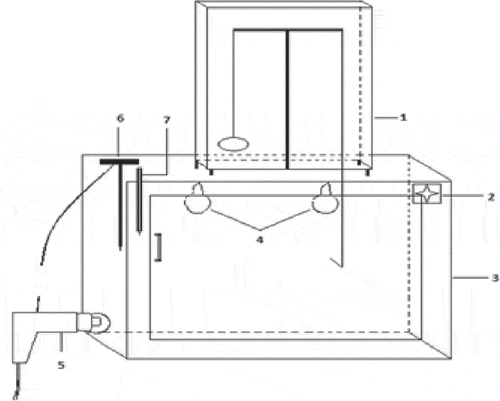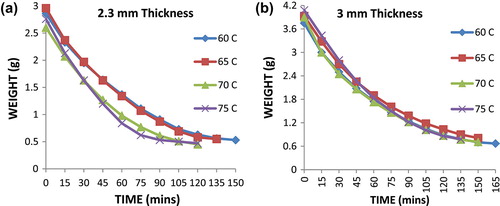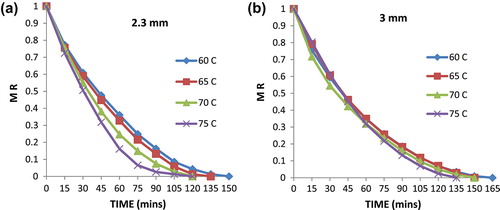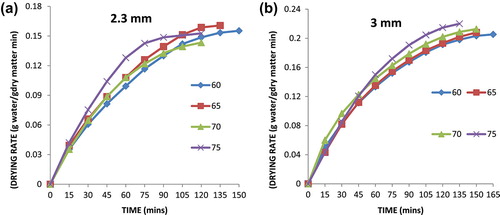Abstract
A laboratory scale cabinet dryer was constructed with an attached weighing balance to calculate changes in the weight of the product without removing it from the dryer. Experiments were conducted to study the effect of process parameters (temperature and thickness) on the drying kinetics of potato. It was observed that the drying process was characterised by a decrease in the moisture ratio with time and showed a non-linear behaviour. No constant rate drying period in the entire process was obtained and all the drying process occurred in the falling rate period, showing that drying in this experiment was mainly controlled by diffusion mechanism. Initially, a higher drying rate was obtained followed by slower moisture removal rate. Increased drying rate and decreased drying time were observed with increase in the dryer temperature.
Public Interest Statement
This study was carried out for developing a small-scale dryer and also describes the drying characteristics of a versatile crop—potato. This study will be helpful for numerous small-scale industries associated with the drying of agricultural produce.
Competing interests
The authors declare no competing interest.
1. Introduction
Drying is the process of moisture removal due to simultaneous heat and mass transfer under controlled conditions (Gatea, Citation2011; Gurlek, Ozbalta, & Gungor, Citation2009; Radhika, Satyanarayana, Rao, & Raju, Citation2011). It is one of the oldest methods of preservation and widely applied owing to its simplicity, ease of operation and cost-effectiveness. Besides these advantages, drying decreases the bulk of foods by reducing the volume which eases handling and processing operations, in turn reducing packaging, handling and storage and transportation costs (Gatea, Citation2011; Goyalde, Melo, Rocha, Goneli, & Araújo, Citation2009; Gupta, Sehgal, & Arora, Citation2011; Kelbaliev & Manafov, Citation2009; Patel & Kar, Citation2012; Wong & Cheung, Citation2001).
Generally hot air is employed as a source to remove the moisture from foods, however, steam/superheated steam, microwaves and infrared radiations are also used in certain cases depending upon the food being dried, type of end product and overall cost. Bondaruk, Markowski, and Błaszczak (Citation2007) and Zaki, Muhamad, and Salleh (Citation2007) reported that hot air drying often degrades the product quality, results in low energy efficiency and lengthy drying time during the falling rate period.
Potato (Solanum tuberosum) is an important crop of the Solanaceae family. Potatoes are used as such or as ingredients in various foods, for starch extractions and other industrial purposes. The demand and use of such crops has increased since recent past due to changing food habits. More than half of the potatoes grown in developed countries are used as processed products (Bakal, Gedam, & Sharma, Citation2010; Olawale & Omole, Citation2012). They are cooked, dried, fried, smoked or used as snacks and other products. Recent years have witnessed the expansion of markets for processed potato products. However, shorter shelf life as a result of deterioration with changes in temperature, humidity and microbial growth makes potatoes unacceptable to consumers. Drying provides an alternative to increase the shelf life of potatoes.
As such, the present study was carried out to study the drying characteristics of potatoes using a self-designed laboratory scale dryer suited for small-scale industries and household purposes to help people of the valley preserve potatoes for usage during harsh winters.
2. Materials and methods
A self-constructed laboratory dryer (60.9 cm × 44.7 cm × 44.7 cm) was constructed and used to dry potatoes (Figure ). The dryer was made using plyboards with a thickness of 12 mm lined with aluminium sheets fixed with a glass door on the front side. An exhaust fan was fixed on the upper inner side of a wall to remove hot humid air during drying. Heat required for drying the samples was provided by a hot air gun (Black & Decker Inc., USA). A mercury/laboratory thermometer was used to check the inside temperature of the dryer, while temperature was regulated using a thermostat with a range of 35–75°C, attached to the hot air gun. A mechanical weighing balance (Roy & Company, Kolkata, India) was placed on the top of the dryer to weigh the samples and measure the change in weights during drying. One pan of the balance was extended to the inside of the chamber where potato samples were to be dried. Similar arrangements have been reported by Azizi and Peyghambarzadeh (Citation2011), Roberts, Kidd, and Padilla-Zakour (Citation2008) and Roberts, Tong, and Lund (Citation2002).
Figure 1. Schematic representation of a self-designed cabinet dryer

Potatoes used for the study were purchased from a local market, checked for bruises, spots and other damages. They were washed and peeled using a peeler with no other pretreatment given to the samples. Potato slices of size 3 cm × 4 cm of two thicknesses (2.3 and 3 mm) were cut using a laboratory scale chopper, equipped with a scale, and analysed for drying kinetics. The drying was carried at 60, 65, 70 and 75°C and for each sample, the thermostat was set to the required temperature and the dryer was kept functional half an hour before drying the samples. Weighing balance was balanced each time before drying the potatoes using known weights equal to the respective weight of the samples and the change in the weight of the potato samples was recorded every 15 min. The data obtained were plotted to get drying curves, drying rate curves and moisture ratio curves using Microsoft excel for Windows 7 OS.
3. Results and discussion
As the drying proceeded, the weight of the samples continued to decrease gradually due to the evaporation or loss of moisture from the potato samples. Data reported show dependency of the drying time on drying temperature and thickness. Samples dried at higher temperatures had a shorter drying time because of higher driving force and vice versa (Doymaz, Citation2011; Leeratanarak, Devahastin, & Chiewchan, Citation2006). Khazaei, Arab-Hosseini, Khosro-Beygi, Izadikhah, and Nasab (Citation2008) reported the dependency of drying kinetics on air temperature, air velocity, material size, drying time, etc. Increased temperatures increased the amount of water removed, thus decreasing the time required to draw out the moisture from the sample. Internal moisture migration is increased by an increase in the heat flux. Hassini, Azzouz, and Belghith (Citation2004) reported the effect of increased temperature on the activity of water, along with the influence on the moisture diffusion coefficient and the enthalpy of vaporisation of the product. Similarly, thick potato slices took more time to dry than thinner ones, as moisture has to travel more distance to the surface by diffusion where the evaporation has to take place.
Figures show a non-linear behaviour of the drying process. Results show that up to 0.1 moisture ratio, the graph shows a linear trend and afterwards it decreases in a non-linear fashion. This may be attributed to the orientation, availability and bonding of water molecules in the food sample (Correa, Resende, & Ribeiro, Citation2006). Initially, heat is taken by the sample to supply sensible heat and only a few portions of the free moisture are evaporated and as the drying advances, the moisture moves out by diffusion. The heat penetrates inside and knocks moisture out leaving a product with decreased water content. In the beginning, drying rate increases owing to the availability of free moisture. As the water content decreases, due to evaporation, more and more moisture moves out to the surface by diffusion, and thereby further decreasing the amount of water to be evaporated which leads to the decline in the drying rate. At last, the water molecules which are strongly bound are to be removed by the heat supplied. At this point, the kinetic energy of molecules increases due to which the temperature of air and the substance equals, which decreases the drying rate and finally brings it to an end. Similar findings have been reported by Zlatkovic and Rajkovic (Citation2005).
Half of the total moisture present was removed during the first hour of the drying process (Table ). All the potato samples had total moisture content in the range of 79–83%. As drying proceeds, a gradual decrease in the water content occurs due to the evaporation of water molecules from the sample. Initially, more than 30% of the moisture content was removed in all samples in the first 30 min and more than 70% during the first two hours of drying. Thicker samples (3 mm) took more time to dry than slices with a thickness of 2.3 mm. The effect of increasing temperature on the drying of samples is quite evident from the data, as it clearly shows increase in temperature decreases the time duration of drying.
Table 1. Loss of moisture during drying (% wet basis)
4. Conclusions
Drying of potatoes is important for the development of ready-to-eat stuffs and to achieve longer shelf stable products. The valley of Kashmir with harsh winters has witnessed rapid expansion in ready-to-eat products and this study shows that the drying of potatoes with a self-designed laboratory scale dryer is possible in order to reduce post harvest losses. The drying of potato slices with two thicknesses at different temperatures ranging from 60 to 70°C was carried. Data plotted showed a non-linear behaviour; however, for the moisture ratio up to 0.1 a linear trend was observed. With increase in the drying temperature, the drying time reduced and samples with more thickness required longer drying time. Higher drying rate was followed by slower moisture removal.
Additional information
Funding
Notes on contributors
Rifat Jabeen
Rifat Jabeen graduated from Islamic University of Science & Technology with Master’s in Food Technology and is currently working at the Division of Post Harvest Technology, SKUAST-K.
Tahmeed Aijaz
Tahmeed Aijaz is an assistant professor at the Department of Food Technology, Islamic University of Science & Technology.
Khalid Gul
Khalid Gul is a doctoral research fellow at Punjab Agricultural University, Ludhiana, specialising in Food biopolymers and bioactives.
References
- Azizi, S. , & Peyghambarzadeh, S. M. (2011). Effect of temperature history on mass transfer diffusivity in convective drying process. World Applied Sciences Journal , 13 , 697–705.
- Bakal, S. B. , Gedam, K. H. , & Sharma, G. P. (2010). Drying characteristics and kinetics of fluidized bed dried potato. Agricultural and Food Science , 19 , 127–135.10.2137/145960610791542307
- Bondaruk, J. , Markowski, M. , & Błaszczak, W. (2007). Effect of drying conditions on the quality of vacuum-microwave dried potato cubes. Journal of Food Engineering , 81 , 306–312.10.1016/j.jfoodeng.2006.10.028
- Correa, P. C. , Resende, O. , & Ribeiro, D. M. (2006). Drying characteristics and kinetics of coffee berry. Revista Brasileira de Produtos Agroindustriais, Campina Grande , 8 , 1–10.
- Doymaz, İ. (2011). Experimental study on drying characteristics of pomegranate peels. Food Science and Biotechnology , 20 , 965–970.10.1007/s10068-011-0133-3
- Gatea, A. A. (2011). Design and construction of a solar drying system, a cylindrical section and analysis of the performance of the thermal drying system. African Journal of Agricultural Research , 6 , 343–351.
- Goyalde, N. A. , Melo, E. C. , Rocha, R. P. , Goneli, A. L. D. , & Araújo, F. L. (2009). Mathematical modelling of the drying kinetics of sugarcane slices. Revista Brasileira de Produtos Agroindustriais, Campina Grande , 11 , 117–121.
- Gupta, M. K. , Sehgal, V. K. , & Arora, S. (2011). Optimization of drying process parameters for cauliflower drying. Journal of Food Science and Technology , 50 , 62–69.
- Gurlek, G. , Ozbalta, N. , & Gungor, A. (2009). Solar tunnel drying characteristics and mathematical modelling of tomato. Journal of Thermal Science and Technology , 29 , 15–23.
- Hassini, L. , Azzouz, S. , & Belghith, A. (2004). Estimation of the moisture diffusion coefficient of potato during hot-air drying. In Proceedings of the 14th International Drying Symposium (pp. 1488–1495), Sao Paulo.
- Kelbaliev, G. I. , & Manafov, M. P. (2009). Mass transfer in the process of drying of porous materials. Journal of Engineering Physics and Thermophysics , 82 , 991–999.10.1007/s10891-009-0270-1
- Khazaei, J. , Arab-Hosseini, A. , Khosro-Beygi, Z. , Izadikhah, N. , & Nasab, S. S. (2008). A new method for modeling the drying kinetics of Zataria multiflora (Avishan shirazi) leaves: Superposition techniques. In World Conference on Agricultural Information and IT , Tokyo.
- Leeratanarak, N. , Devahastin, S. , & Chiewchan, N. (2006). Drying kinetics and quality of potato chips undergoing different drying techniques. Journal of Food Engineering , 77 , 635–643.10.1016/j.jfoodeng.2005.07.022
- Olawale, A. S. , & Omole, S. O. (2012). Thin layer drying models for sweet potato in tray dryer. Agriculture Engineering International: The CIGR Journal , 14 , 131–137.
- Patel, K. K. , & Kar, A. (2012). Heat pump assisted drying of agricultural produce-an overview. Journal of Food Science and Technology , 49 , 142–160.10.1007/s13197-011-0334-z
- Radhika, G. B. , Satyanarayana, S. V. , Rao, D. G. , & Raju, B. V. (2011). Mathematical model on thin layer drying of finger millet (Eluesine coracana). Advanced Journal of Food Science and Technology , 3 , 127–131.
- Roberts, J. S. , Kidd, D. R. , & Padilla-Zakour, O. (2008). Drying kinetics of grape seeds. Journal of Food Engineering , 89 , 460–465.10.1016/j.jfoodeng.2008.05.030
- Roberts, J. S. , Tong, C. H. , & Lund, D. B. (2002). Drying kinetics and time-temperature distribution of pregelatinized bread. Journal of Food Science , 67 , 1080–1087.10.1111/jfds.2002.67.issue-3
- Wong, K. , & Cheung, P. C. (2001). Influence of drying treatment on three Sargassum species. Journal of Applied Phycology , 13 , 43–50.10.1023/A:1008149215156
- Zaki, N. A. M. , Muhamad, I. I. , & Salleh, L. M. (2007). Drying characteristics of papaya (Carica papaya L.) during microwave-vacuum treatment. International Journal of Engineering and Technology , 4 , 15–21.
- Zlatkovic, B. P. , & Rajkovic, M. B. (2005). Analysis of drying potato kinetics in laboratory conditions. Journal of Agricultural Sciences , 50 , 161–171.



